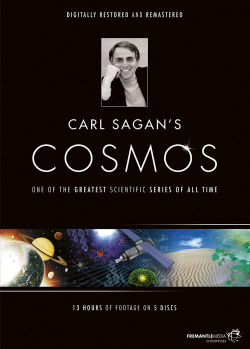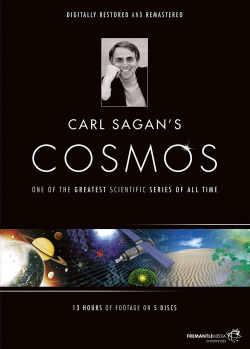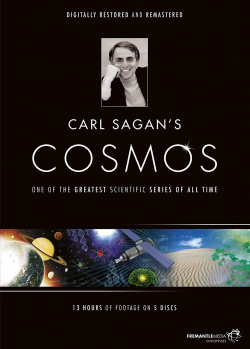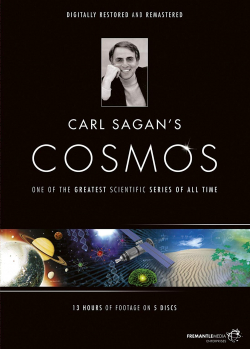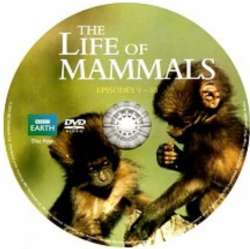Carl Sagan's Cosmos Cosmos - Episodes 10-12
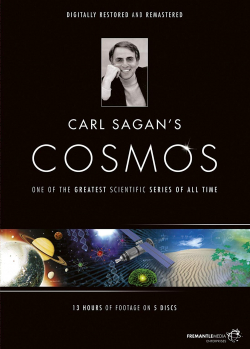
Type
Audio/Visual
Authors
Sagan ( Carl )
Category
DVD - Episode/s of series
[ Browse Items ]
Publisher
Fremantle Media Enterprises, United States
Series Name
Abstract
Carl Sagan explores the universe in this monumental cosmic journey. A fascinating blend of science, education, and entertainment that covers everything from the cells which build life to the Big Bang that started it all. The cosmos is all that is, ever was, or ever will be... we are, all of us, made of star-stuff.
Cosmos tells the fascinating story of how nearly fifteen billion years of cosmis evolution transformed matter and life into consciousness, of how science and civilisation grew up together and of the forces and individuals who helped shape modern science.
Astronomer Dr Carl Sagan is host and narrator of this amazing 13 hour series, now digitally remaster, restored and enhanced. With topics including the origins of life, the search for extra-terrestrial life, the "greenhouse effect", the lives of stars, interstellar travel and the effects of attaining the speed of light, this is a fascinating insight into humanity and the universe.
Cosmos tells the fascinating story of how nearly fifteen billion years of cosmis evolution transformed matter and life into consciousness, of how science and civilisation grew up together and of the forces and individuals who helped shape modern science.
Astronomer Dr Carl Sagan is host and narrator of this amazing 13 hour series, now digitally remaster, restored and enhanced. With topics including the origins of life, the search for extra-terrestrial life, the "greenhouse effect", the lives of stars, interstellar travel and the effects of attaining the speed of light, this is a fascinating insight into humanity and the universe.
Description
Episode 10: The Edhe of Forever
Beginning with the origins of the universe in the Big Bang, Sagan describes the formation of different types of galaxies and anomalies such as galactic collisions and quasars. The episode moves further into ideas about the structure of the Universe, such as different dimensions (in the imaginary Flatland and four-dimensional hypercubes), an infinite vs. a finite universe, and the idea of an oscillating Universe (similar to that in Hindu cosmology). The search into other ideas such as dark matter and the multiverse is shown, using tools such as the Very Large Array in New Mexico. Cosmos Update shows new information about the odd, irregular surfaces of galaxies and the Milky Way perhaps being a barred spiral galaxy.
Episode 11: The Persistence of Memory
The idea of intelligence is explored in the concepts of computers (using bits as their basic units of information), whales (in their songs and their disruptions by human activities), DNA, the human brain (the evolution of the brain stem, frontal lobes, neurons, cerebral hemispheres, and corpus callosum under the Triune Brain Model), and man-made structures for collective intelligence (cities, libraries, books, computers, and satellites). The episode ends with speculation on alien intelligence and the information conveyed on the Voyager Golden Record.
Episodes 12: Encyclopaedia Galactica
Questions are raised about the search for intelligent life beyond the Earth, with UFOs and other close encounters refuted in favor of communications through SETI and radio telescope such as the Arecibo Observatory. The probability of technically advanced civilizations existing elsewhere in the Milky Way is interpreted using the Drake equation and a future hypothetical Encyclopedia Galactica (similar to Rosetta Stone) is discussed as a repository of information about other worlds in the galaxy. The Cosmos Update notes that there have been fewer sightings of UFOs and more stories of abductions, while mentioning the META scanning the skies for signals.
Beginning with the origins of the universe in the Big Bang, Sagan describes the formation of different types of galaxies and anomalies such as galactic collisions and quasars. The episode moves further into ideas about the structure of the Universe, such as different dimensions (in the imaginary Flatland and four-dimensional hypercubes), an infinite vs. a finite universe, and the idea of an oscillating Universe (similar to that in Hindu cosmology). The search into other ideas such as dark matter and the multiverse is shown, using tools such as the Very Large Array in New Mexico. Cosmos Update shows new information about the odd, irregular surfaces of galaxies and the Milky Way perhaps being a barred spiral galaxy.
Episode 11: The Persistence of Memory
The idea of intelligence is explored in the concepts of computers (using bits as their basic units of information), whales (in their songs and their disruptions by human activities), DNA, the human brain (the evolution of the brain stem, frontal lobes, neurons, cerebral hemispheres, and corpus callosum under the Triune Brain Model), and man-made structures for collective intelligence (cities, libraries, books, computers, and satellites). The episode ends with speculation on alien intelligence and the information conveyed on the Voyager Golden Record.
Episodes 12: Encyclopaedia Galactica
Questions are raised about the search for intelligent life beyond the Earth, with UFOs and other close encounters refuted in favor of communications through SETI and radio telescope such as the Arecibo Observatory. The probability of technically advanced civilizations existing elsewhere in the Milky Way is interpreted using the Drake equation and a future hypothetical Encyclopedia Galactica (similar to Rosetta Stone) is discussed as a repository of information about other worlds in the galaxy. The Cosmos Update notes that there have been fewer sightings of UFOs and more stories of abductions, while mentioning the META scanning the skies for signals.
Biblio Notes
Total running time: 180 minutes
Number of Copies
1
| Library | Accession No | Call No | Copy No | Edition | Location | Availability |
|---|---|---|---|---|---|---|
| Main | 2344 | 1 | Yes |
